Duke Energy has decided against pursuing offshore wind development along North Carolina’s coast after an independent review concluded the projects are not economically competitive at this time. Duke Energy is the largest electric utility in North Carolina and one of the biggest in the United States.
The move comes at a time when offshore wind projects are facing significant headwinds. A week ago Atlantic Shores Offshore wind power project was terminated by the New Jersey Regulator who cancelled the preliminary approval following a request from the developers.
The review stemmed from an Acquisition Request for Information (ARFI)—a regulator-ordered process designed to collect confidential project details and pricing from leaseholders. Duke Energy stated that “offshore wind is not cost-competitive at this time, so no RFP will be issued.”
An RFP (Request for Proposal) is a formal process where companies are invited to submit competitive bids for a project. Unlike an ARFI, which is used only to gather information and pricing details, an RFP signals that the project will move forward and that developers can compete to be selected. In this case, because offshore wind proposals were found to be too costly, Duke Energy decided not to issue an RFP, halting the competitive bidding process.
Despite the decision, the utility noted that the process provided valuable cost and scheduling data that will inform its upcoming Carolinas Resource Plan.
Results of the ARFI
Launched in January, the ARFI invited confidential submissions from three leaseholders:
-
Avangrid – controlling the Kitty Hawk lease area.
-
TotalEnergies – leaseholder of part of the Carolina Long Bay tract.
-
Cinergy (Duke Energy subsidiary) – controlling the other portion of Carolina Long Bay.
The ARFI sought bids for up to 2,400 megawatts of offshore wind capacity by 2035, which would have been enough to power approximately 1.5 million homes.
When the results were filed with the North Carolina Utilities Commission on August 11, all bids came in above the established “reference price,” which was based on the cost of solar paired with battery storage. Independent evaluator Power Advisory validated the findings.
Critics Support the Move
Opponents of offshore wind projects welcomed Duke’s decision. Jon Sanders, director of the Center for Food, Power and Life at the John Locke Foundation, argued that the state must prioritize affordability and reliability.
“Even if climate change projections are taken at their strongest, North Carolina is too small to make a measurable global impact,” Sanders said. “But residents could face higher power bills without meaningful environmental benefits.”
Sanders added that while future technological advances could change the outlook, he does not expect offshore wind to become viable in the near term.
Factsheet: Duke Energy Offshore Wind Review
-
Process: Acquisition Request for Information (ARFI)
-
Purpose: Assess cost and project feasibility for offshore wind in NC
-
Timeline: ARFI launched in January, results filed August 11, 2025
-
Leaseholders Involved: Avangrid (Kitty Hawk), TotalEnergies & Cinergy (Carolina Long Bay)
-
Capacity Considered: 2,400 MW by 2035
-
Homes Powered: ~1.5 million
-
Outcome: All bids exceeded solar + battery storage benchmark price
-
Evaluator: Power Advisory (independent)
-
Decision: No RFP issued; data will inform future Carolinas Resource Plan

